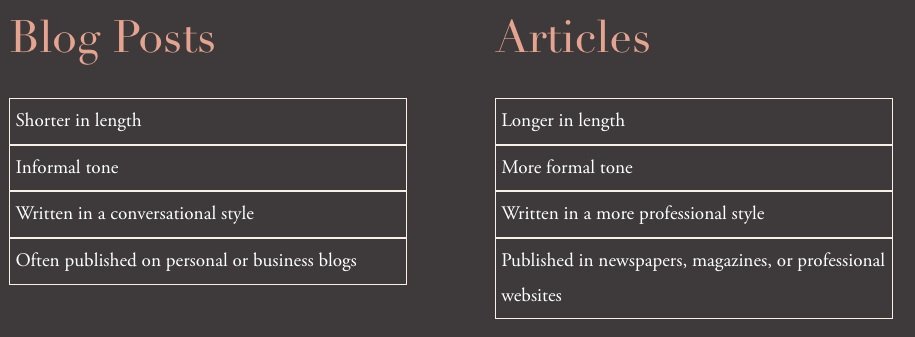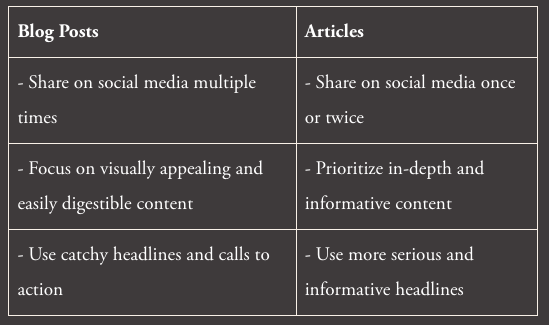Blog Post vs Article: What's the Difference (and Why Does It Matter?)
Here's the short answer to writing a blog post vs article: it comes down to length, expertise, and location.
A blog post is normally around 1,000 words, opinionated without a huge amount of research, and on a blog (as you’d guess from the name).
An article is closer to 1,500-2,000 words, usually more of an expert piece of work, and more frequently in a publication or magazine.
People, including me, use the two interchangeably. But there is a difference, and knowing it does matter, especially when you're pitching your content to others. You don't want to offer a blog post when you mean an article, or vice versa.
Let's dive into the nitty gritty differences between a blog post and an article, and talk about why and when this distinction matters.
As an example: this piece of content is a blog post. 🤓
Defining a Blog Post and an Article
I did the short version, now let's look at the longer version of definitions.
A blog post is a piece of content published on a blog, typically consisting of shorter, informal entries written in a conversational tone.
An article is a more formal, longer piece of content published in magazines, newspapers, or websites, often written in a more professional tone.
One key difference between writing blog posts and articles is your intended purpose. Blog posts are often created to inform, entertain, or engage with the audience, while articles are typically more informative and intended to provide the reader with in-depth knowledge on a specific topic.
What about… a blog article?
The line between writing blog posts and articles can sometimes be blurred, especially with the rise of online publishing. While blog posts are traditionally associated with personal or business blogs, many writers use the term "article" to refer to any written content published on their website, even if it's shorter and more engaging.
This can happen in the opposite direction. For instance, I've seen many a LinkedIn post that qualifies as an article – they're long, focused, and written in a professional tone. (Maybe that's why it's called a LinkedIn article!)
Another difference between writing blog posts and articles is the level of interactivity they offer to the audience. Blog posts often encourage readers to leave comments and engage in discussions, while articles are typically read for information and do not have the same level of interaction.
Writing Style and Structure
Now that I’ve defined what distinguishes a blog post from an article, let's examine the differences in writing style and structure that set them apart.
Word Count: A major differentiating factor is word count. Blog posts are often shorter, typically ranging from 500 to 1,500 words, while articles can be much longer, with some exceeding 10,000 words. This is normally because blog authors just have less to say. Articles, meanwhile are meant to offer an in-depth exploration of a topic.
Tone: Another factor is tone. Blog posts are typically written in a conversational tone, with a focus on engagement and establishing a connection with the reader. Articles, on the other hand, are more formal and academic in tone, with a focus on presenting information objectively and thoroughly.
Formatting: Blog posts are often broken up into short paragraphs or bulleted lists to make them easier to scan and read. Articles, on the other hand, tend to be structured with section headings, subheadings, and longer paragraphs to guide the reader through a more complex argument or narrative.
Image Usage: Images are often used more frequently and prominently in blog posts, as they help break up text and make the content more visually appealing. In articles, images are typically used to illustrate a point or provide evidence, and are not as central to the overall structure of the piece.
Side note: in part, I don't like to use images in my blog posts because I find them infantilizing and distracting. So to each their own.
I want to be clear. One is not better than the other. Writing a blog post is like a quick chat with a friend over coffee, while an article is more like a scholarly lecture. Both have their place, but it's important to use the right format for the message you're trying to convey.
Content and Purpose
Blog posts are designed to inform or entertain readers in a casual, relatable way, often incorporating personal anecdotes or opinions. Articles, on the other hand, provide in-depth analysis and factual information on a specific topic or issue.
This difference in content is reflected in their respective audiences. Blog posts typically target a broad audience with a variety of interests, while articles aim for a more specialized audience with a particular focus.
Both articles and blog posts can serve as content marketing, as long as they are both quality content.
What Makes a Good Blog Post?
You as a reader should have a good idea of what makes a good blog post. Ask yourself: when did you last stay and read to the bottom of a blog post? Why?
A good blog post is shorter content that captures the reader's attention with an engaging hook and maintains their interest with relevant, valuable information. It should be written in a conversational tone and can incorporate images or videos to break up the text.
The ideal blog post length varies depending on the topic and audience, but writing anywhere from 500-1500 words is generally considered appropriate.
When it comes to search engine optimization, blog posts should incorporate relevant keywords without sacrificing readability or quality.
What Makes a Good Article?
A good article presents a comprehensive, well-researched analysis of a specific topic or issue. It should be written in a formal tone and include a clear introduction, body, and conclusion.
The ideal article length is typically more long form content than a blog post, ranging from 1500-5000 words or more. It should incorporate a variety of sources and provide citations for all factual information.
When it comes to SEO, articles should be optimized for search engines and incorporate relevant keywords, but the focus should be on providing valuable information rather than keyword stuffing.
SEO and Optimization
When it comes to SEO and optimization, the process of writing blog posts and articles has some similarities, but also some key differences.
Both blog content and articles benefit from keyword research and optimization to improve their search engine rankings. However, the optimal keyword usage and structure can vary between the two formats.
Additionally, the structure of a blog post makes it easier to optimize for SEO. The shorter length and frequent use of headings and subheadings allow for more targeted keyword usage and a clear structure that search engines can easily parse.
Articles may require more strategic use of keywords and formatting to optimize for search engines, due to their longer length and potential for a more complex structure.
Engagement and Interaction
Now that we've explored the ins and outs of writing blog posts and articles, let's talk about how readers engage with both types of content.
Generally, blog posts tend to be more conversational in tone and encourage discussion through comments sections. Articles, on the other hand, often take a more formal approach and might not elicit as much direct interaction from readers.
However, well-written articles can also spark thoughtful conversations and social media shares.
Ultimately, whether you choose to be writing blog posts or articles, it's important to consider the level of engagement and interaction you want to encourage with your readers.
Strategies for Blog Posts versus Articles
While the same promotion and sharing strategies can be applied to both blog posts and articles, there are some differences in how they are best utilized.
These are the recommended best practices, though of course you can do differently if it suits you. I, for instance, only ever share my content once in my newsletter whether it's a blog post or an article.
Remember, the best way to promote and share your content is to understand your target audience and tailor your approach to their preferences. Keep experimenting with different strategies and platforms until you find what works best for you.


